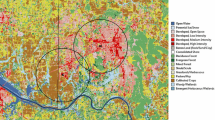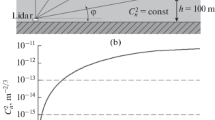Abstract
We utilized a Doppler lidar to measure spectra of vertical velocity w from 390m above the surface to the top of the daytime convective boundary layer (CBL). The high resolution 2μm wavelength Doppler lidar developed by the NOAA Environmental Technology Laboratory was used to detect the mean radial velocity of aerosol particles. It operated continuously during the daytime in the zenith-pointing mode for several days in summer 1996 during the Lidars-in-Flat-Terrain experiment over level farmland in central Illinois, U.S.A. The temporal resolution of the lidar was about 1 s, and the range-gate resolution was about 30m. The vertical cross-sections were used to calculate spectra as a function of height with unprecedented vertical resolution throughout much of the CBL, and, in general, we find continuity of the spectral peaks throughout the depth of the CBL. We compare the observed spectra with previous formulations based on both measurements and numerical simulations, and discuss the considerable differences, both on an averaged and a case-by-case basis. We fit the observed spectra to a model that takes into account the wavelength of the spectral peak and the curvature of the spectra across the transition from low wavenumbers to the inertial subrange. The curvature generally is as large or larger than the von Kármán spectra. There is large case-to-case variability, some of which can be linked to the mean structure of the CBL, especially the mean wind and the convective instability. We also find a large case-to-case variability in our estimates of normalized turbulent kinetic energy dissipation deduced from the spectra, likely due for the most part to a varying ratio of entrainment flux to surface flux. Finally, we find a relatively larger contribution to the low wavenumber region of the spectra in cases with smaller shear across the capping inversion, and suggest that this may be due partly to gravity waves in the inversion and overlying free atmosphere.
Similar content being viewed by others
References
Angevine WM (1999) Entrainment results including advection and case studies from the Flatland boundary layer experiments. J Geophys Res 104: 30,947–30,963
Angevine WM, Grimsdell AW, Hartten LM, Delany AC (1998) The Flatland boundary layer experiments. Bull Am Meteorol Soc 79: 419–431
Banakh VA, Smalikho IN (1999) Measurements of turbulent energy dissipation rate with a CW Doppler lidar in the atmospheric boundary layer. J Atmos Ocean Technol 16: 1044–1061
Canut G, Lothon M, Said F (2009) Observation of entrainment at the interface between monsoon flow and Saharan Air Layer. Q J Roy Meteorol Soc (in press)
Caughey SJ, Palmer SG (1979) Some aspects of turbulence structure through the depth of the convective boundary layer. Q J Roy Meteorol Soc 105: 811–827
Cohn SA, Angevine WM (2000) Boundary layer height and entrainment zone thickness measured by lidars and wind-profiling radars. J Appl Meteorol 39: 1233–1247
Cohn SA, Mayor SD, Grund TM, Weckwerth TM, Sneff C (1998) The Lidars in Flat Terrain experiment LIFT. Bull Amer Meteorol Soc 79: 1329–1343
Conzemius RJ, Fedorovich E (2006) Dynamics of sheared convective boundary layer entrainment. Part I: methodology background and large-eddy simulations. J Atmos Sci 63: 1151–1178
Conzemius RJ, Fedorovich E (2007) Bulk models of the sheared convective boundary layer: Evaluation through large eddy simulations. J Atmos Sci 64: 786–807
Emeis S, Schafer K, Munkel C (2008) Surface-based remote sensing of the mixing-layer height—a review. Meteorol Z 17: 621–630
Grimsdell AW, Angevine WM (1998) Convective boundary layer height measurement with wind profilers and comparison to cloud base. J Atmos Oceanic Technol 15: 1331–1338
Grimsdell AW, Angevine WM (2002) Observations of the afternoon transition of the convective boundary layer. J Appl Meteorol 41: 3–11
Grund CJ, Banta RM, George JL, Howell JN, Post MJ, Richter RA, Weickman AM (2001) High-resolution Doppler lidar for boundary layer and cloud research. J Atmos Oceanic Technol 18: 376
Hageli P, Steyn DG, Strawbridge KB (2000) Spatial and temporal variability of mixed-layer depth and entrainment zone thickness. Boundary-Layer Meteorol 97: 47–71
Hicks BB, Wesely ML (1981) Heat and momentum transfer characteristics of adjacent fields of soybeans and maize. Boundary-Layer Meteorol 20: 175–185
Hogstrom U (1996) Review of some basic characteristics of the atmospheric surface layer. Boundary-Layer Meteorol 78: 215–246
Højstrup J (1982) Velocity spectra in the unstable planetary boundary layer. J Atmos Sci 39: 2239–2248
Kaimal JC, Wyngaard JC, Coté OR (1972) Spectral characteristics of surface layer turbulence. Q J Roy Meteorol Soc 98: 653–689
Kaimal JC, Wyngaard JC, Haugen DA, Coté OR, Izumi Y (1976) Turbulence structure in the convective boundary layer. J Atmos Sci 33: 2152–2169
Kaimal JC, Eversole RA, Lenschow DH (1982) Spectral characteristics of the convective boundary-layer over uneven terrain. J Atmos Sci 39: 1098–1114
Kàrmàn TV (1948) Progress in the statistical theory of turbulence. Proc Nat Akad Sci 34: 530–539
Katul G, Chu C-R (1998) A theoretical and experimental investigation of energy-containing scales in the dynamic sublayer of boundary-layer flows. Boundary-Layer Meteorol 86: 279–312
Kim S, Park S, Moeng CH (2003) Entrainment processes in the convective boundary layer with varying wind shear. Boundary-Layer Meteorol 108: 221–245
Kristensen L, Lenschow DH, Kirkegaard P, Courtney M (1989) The spectral velocity tensor for homogeneous boundary layer turbulence. Boundary-Layer Meteorol 47: 149–193
Lammert A, Boesenberg J (2006) Determination of the convective boundary-layer height with laser remote sensing. Boundary-Layer Meteorol 119: 159–170
Lenschow DH (1974) Model of the height variation of the turbulence kinetic energy budget in the unstable planetary boundary layer. J Atmos Sci 31: 465–474
Lenschow DH, Stankov BB (1986) Length scales in the convective boundary layer. J Atmos Sci 43: 1198–1209
Lenschow DH, Wulfmeyer V, Senff C (2000) Measuring second- through fourth-order moments in noisy data. J Atmos Ocean Technol 17: 1330–1347
Lothon M, Lenschow DH, Mayor S (2006) Coherence and scale of vertical velocity in the convective boundary-layer. Boundary-Layer Meteorol 121: 521–536
Mahrt L, Lenschow DH (1976) Growth dynamics of the convective mixed layer. J Atmos Sci 33: 41–51
Mann J (1994) The spatial structure of neutral atmospheric surface-layer turbulence. J Fluid Mech 273: 141–168
Martucci G, Matthey R, Mitev V, Richner H (2007) Comparison between backscatter lidar and radiosonde measurements of the diurnal and nocturnal stratification in the lower troposphere. J Atmos Oceanic Technol 24: 1231–1244
Militzer JM, Michaelis MC, Semmer SR, Norris KS, Horst TW, Oncley SP, Delany AC, Brock FV (1995) Development of the prototype PAMIII/Flux-PAM surface meteorological station. In: Proceedings of the 9th symposium on meteorological observations and instrumentation, American Meteorological Society, Boston, pp 490–494
Paulson CA (1970) The mathematical representation of wind speed and temperature profiles in the unstable atmospheric boundary layer. J Appl Meterol 9: 857–861
Sullivan PP, Moeng CH, Stevens B, Lenschow DH, Mayor SD (1998) Structure of the entrainment zone capping the convective atmospheric boundary layer. J Atmos Sci 55: 3042–3064
Tennekes H (1973) A model for the dynamics of the inversion above a convective boundary layer. J Atmos Sci 30: 538–567
Weckwerth T (1999) An observational study of the evolution of horizontal convective rolls. Mon Weather Rev 127: 2160–2179
White AB, Senff CJ, Banta RM (1999) A comparison of mixing depths observed by ground-based wind profilers and an airborne lidar. J Atmos Oceanic Technol 16: 584–590
Wilczak JM, Gossard EE, Neff WD, Eberhard WL (1996) Ground-based remote sensing of the atmospheric boundary layer: 25 years of progress. Boundary-Layer Meteorol 78: 321–349
Author information
Authors and Affiliations
Corresponding author
Rights and permissions
About this article
Cite this article
Lothon, M., Lenschow, D.H. & Mayor, S.D. Doppler Lidar Measurements of Vertical Velocity Spectra in the Convective Planetary Boundary Layer. Boundary-Layer Meteorol 132, 205–226 (2009). https://doi.org/10.1007/s10546-009-9398-y
Received:
Accepted:
Published:
Issue Date:
DOI: https://doi.org/10.1007/s10546-009-9398-y




